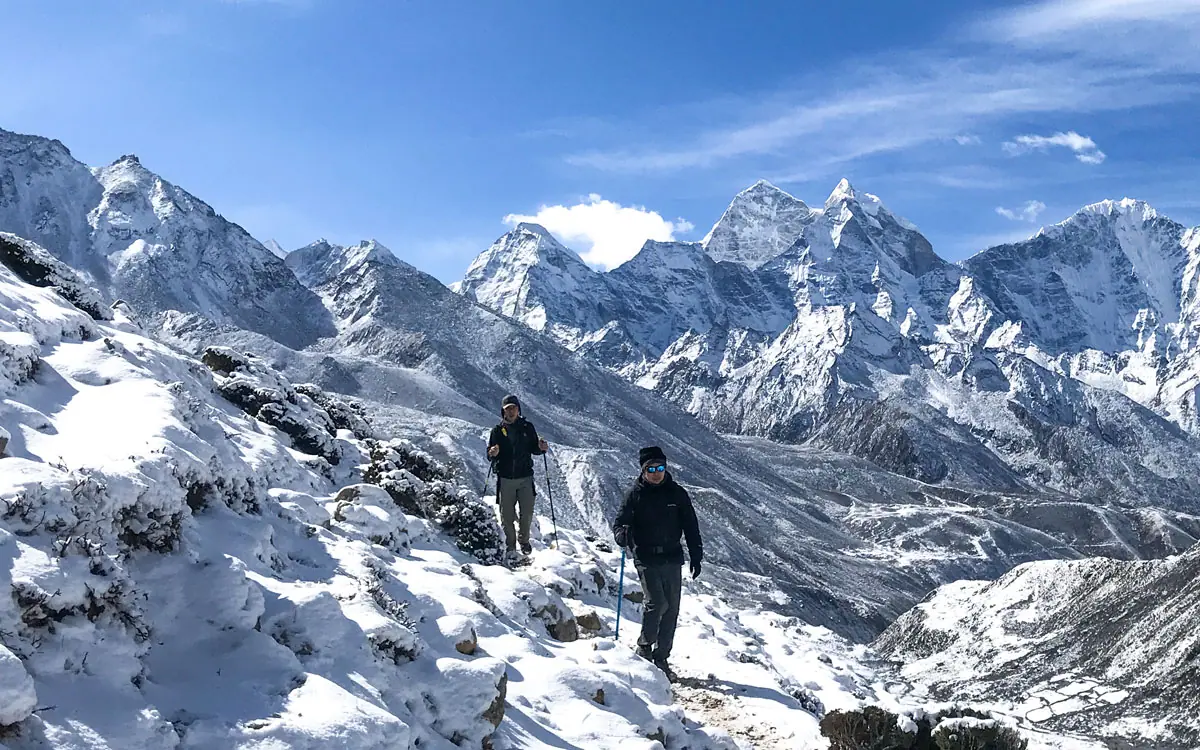Acclimatizing on the Annapurna Circuit Trek is crucial to avoid altitude sickness and ensure a safe and enjoyable journey. As you ascend through diverse altitudes, ranging from lush lowlands to the high-altitude passes, your body must gradually adjust to decreasing oxygen levels. Proper acclimatization involves a combination of physical preparation, gradual ascent, and mindful practices to minimize the risk of altitude-related issues.
Preparation before the trek is essential for a successful acclimatization process. Engaging in cardiovascular exercise, such as hiking or jogging, helps build the stamina and endurance needed for the trek. Strengthening your respiratory system through regular exercise can also prepare your body for higher altitudes. It’s beneficial to start your trek in good physical condition, as this can help your body handle the stresses of altitude more effectively.
During the trek, the key to acclimatizing is to ascend gradually. The 14-day Annapurna Circuit Trek is designed with a steady ascent, allowing for adequate acclimatization. Follow the recommended itinerary, which typically includes days dedicated to acclimatization at certain elevations. These acclimatization days involve short hikes to higher altitudes during the day, followed by a return to lower altitudes to sleep. This approach helps your body adapt to the thinning air without the stress of continuous high-altitude exposure.
Hydration plays a significant role in preventing altitude sickness. Drink plenty of fluids throughout the trek to stay well-hydrated. Water helps your body adjust to altitude and can alleviate symptoms such as headaches and dizziness. It’s advisable to avoid alcohol and excessive caffeine, as these can contribute to dehydration and hinder your acclimatization process.
Eating a balanced diet rich in carbohydrates can also support your acclimatization. Carbohydrates are easier to digest and provide the energy needed for the physical exertion of trekking. Consuming regular meals and snacks can help maintain your energy levels and support overall health during the trek.
Listening to your body is vital when acclimatizing. Symptoms of altitude sickness, such as headaches, nausea, and dizziness, should be taken seriously. If you experience these symptoms, it’s important to inform your guide and take the necessary precautions, such as resting or descending to a lower altitude if needed. Overexertion can exacerbate symptoms, so maintain a steady pace and avoid pushing yourself too hard.
Proper rest is another key element in acclimatization. Ensure you get adequate sleep each night, as this helps your body recover and adjust to the altitude. If you feel fatigued, take breaks and allow yourself time to rest.
By preparing physically before the trek, ascending gradually, staying hydrated, eating well, and listening to your body, you can effectively acclimatize and reduce the risk of altitude sickness. These practices contribute to a safer and more enjoyable Annapurna Circuit Trek, allowing you to fully experience the breathtaking landscapes and cultural richness of the Himalayas.
Understanding Altitude Sickness
Altitude sickness, or acute mountain sickness (AMS), occurs when individuals ascend to high altitudes too quickly without allowing their bodies sufficient time to adjust. As you climb higher, the amount of oxygen in the air decreases, making it harder for your body to get the oxygen it needs. This can lead to a range of symptoms, from mild discomfort to severe health issues. The reduced oxygen levels can impair the body’s ability to perform essential functions, leading to symptoms like headaches, nausea, dizziness, and fatigue.
In more severe cases, altitude sickness can develop into high-altitude pulmonary edema (HAPE) or high-altitude cerebral edema (HACE), which are potentially life-threatening conditions. Understanding how altitude sickness manifests and the factors that contribute to it is crucial for preventing and managing it effectively. Adequate acclimatization, proper hydration, and paying attention to your body’s signals are key strategies to mitigate the risks associated with high-altitude trekking.
Importance of Acclimatization
Acclimatization is vital for reducing the risk of altitude sickness and ensuring a successful trek at high altitudes, such as on the Annapurna Circuit. When ascending to higher elevations, the body needs time to adapt to the lower levels of oxygen. Acclimatization involves gradually increasing your altitude and allowing your body to adjust through a series of planned, gradual climbs and rests. This process helps your body produce more red blood cells to carry oxygen more efficiently and improves overall oxygen utilization. Without proper acclimatization, trekkers are more susceptible to altitude sickness, which can significantly impact their health and safety.
By incorporating acclimatization days into your trek and ascending slowly, you give your body the opportunity to adjust and reduce the likelihood of severe altitude-related issues. This approach is essential for maintaining physical well-being and ensuring a more enjoyable trekking experience.
Signs and Symptoms of Altitude Sickness
Altitude sickness can present with a range of symptoms, which typically start with mild discomfort and can progress to more severe conditions if not addressed. Common signs include headaches, nausea, dizziness, fatigue, and shortness of breath. Mild symptoms are often a result of the body struggling to cope with reduced oxygen levels and can be managed with rest and hydration. As altitude sickness progresses, symptoms may include insomnia, loss of appetite, and a general feeling of unwellness.
More severe cases can lead to high-altitude pulmonary edema (HAPE), characterized by a persistent cough, difficulty breathing, and fluid buildup in the lungs, or high-altitude cerebral edema (HACE), which involves confusion, coordination problems, and severe headaches. Recognizing these symptoms early is crucial for effective management. If you or a fellow trekker experience worsening symptoms, it’s important to seek medical assistance and consider descending to a lower altitude to prevent serious health complications.
Tips for Effective Acclimatization
Effective acclimatization is essential for minimizing the risk of altitude sickness and ensuring a successful high-altitude trek. One of the primary strategies is to follow a gradual ascent, which involves increasing your altitude slowly and incorporating rest days to allow your body to adjust. It’s also beneficial to stay hydrated by drinking plenty of fluids, as dehydration can exacerbate symptoms of altitude sickness. Eating a balanced diet with ample carbohydrates can provide the energy needed for physical exertion and help your body cope with the higher altitude.
Additionally, avoiding alcohol and excessive caffeine can prevent dehydration and support better acclimatization. Monitoring your body’s response to altitude changes and taking rest breaks as needed is crucial. If symptoms of altitude sickness arise, it’s important to rest and, if necessary, descend to a lower altitude. By adhering to these acclimatization tips, trekkers can improve their chances of a safe and enjoyable experience at high elevations.
Gradual Ascents: The Key Strategy
Gradual ascents are the cornerstone of effective acclimatization and play a crucial role in preventing altitude sickness on the Annapurna Circuit Trek. The principle behind gradual ascents is to allow the body to acclimate to decreasing oxygen levels in a controlled manner. This involves ascending slowly and incorporating acclimatization days, where you hike to higher altitudes during the day but return to a lower altitude to sleep.
This method helps your body adapt to the lower oxygen levels by improving oxygen utilization and increasing red blood cell production. Trekking itineraries on the Annapurna Circuit are often designed to include these gradual ascents, with planned rest days to support acclimatization. By following a gradual ascent strategy, trekkers minimize the risk of altitude sickness and give their bodies the necessary time to adjust, enhancing their overall trekking experience and safety.
Staying Hydrated: Importance of Water
Staying hydrated is crucial for maintaining health and performance during the Annapurna Circuit Trek, especially at high altitudes where dehydration can exacerbate symptoms of altitude sickness. At higher elevations, the body loses water more rapidly due to increased respiration rates and drier air. Proper hydration helps the body adapt to the lower oxygen levels by supporting blood circulation and metabolic functions. Drinking plenty of water aids in preventing headaches, dizziness, and fatigue, which are common symptoms of dehydration and altitude sickness.
Aim to drink around 3 to 4 liters of water daily, adjusting based on your exertion levels and weather conditions. It’s also wise to carry water purification tablets or a filter, as water sources along the trek may not always be clean. Hydration should be continuous, not just in response to thirst, to keep your body well-maintained throughout the trek. Proper hydration ensures that your body can cope better with the physical demands of the trek and helps in effective acclimatization, contributing to a safer and more enjoyable experience.
Nutrition Tips for High Altitudes
Proper nutrition is a key factor in managing the physical challenges of high-altitude trekking on the Annapurna Circuit With Tilicho Lake. At high altitudes, your body requires more energy and nutrients to cope with the reduced oxygen levels and increased physical exertion. Carbohydrates are especially important as they provide a readily available source of energy and are easier to digest than proteins or fats. Include foods such as rice, pasta, and potatoes in your meals to sustain energy levels.
Protein is also important for muscle repair and recovery, so incorporate lean meats, legumes, and dairy products into your diet. Additionally, eating small, frequent meals can help maintain energy levels and prevent digestive issues. It’s advisable to avoid heavy, greasy foods that can be harder to digest at high altitudes. Consuming a variety of foods ensures that you get essential vitamins and minerals, which support overall health and stamina. Balanced nutrition, combined with proper hydration and rest, is essential for acclimatization and a successful trekking experience.
The Role of Rest Days
Rest days play a critical role in effective acclimatization and overall well-being during the Annapurna Circuit Trek. These designated days are strategically placed in the trekking itinerary to allow your body time to adjust to the increasing altitude. On rest days, you typically remain at the same elevation while taking short, gentle hikes to higher altitudes and then returning to your resting spot. This practice helps stimulate the body’s acclimatization process without the added strain of continuous ascent.
Adequate rest allows your body to recover from physical exertion, reduces fatigue, and helps prevent altitude sickness by giving your lungs and circulatory system time to adapt to the lower oxygen levels. Proper rest also supports overall health by ensuring that your muscles and joints are not overworked. Following a well-planned itinerary that includes regular rest days is essential for a safe and enjoyable trek, facilitating better acclimatization and reducing the risk of altitude-related complications.
Utilizing Diamox and Other Medications
Diamox (acetazolamide) is a medication commonly used to prevent and alleviate the symptoms of altitude sickness during high-altitude treks like the Annapurna Circuit. It works by accelerating the acclimatization process, making it easier for the body to adjust to reduced oxygen levels. While Diamox can be effective in reducing the risk of altitude sickness, it is important to use it under the guidance of a healthcare professional.
Typically, Diamox is taken starting a day or two before ascending to high altitudes and continued for a few days during the trek. Besides Diamox, other medications such as pain relievers can help manage mild symptoms like headaches. However, relying solely on medication is not a substitute for proper acclimatization, hydration, and pacing. Always consult with a healthcare provider before taking any medication, and follow their recommendations on dosage and usage. Medications should be part of a comprehensive approach to managing altitude sickness, complementing strategies such as gradual ascent and proper hydration.
Breathing Techniques for Acclimatization
Breathing techniques can significantly aid in acclimatization and enhance overall performance during the Annapurna Circuit Trek. At high altitudes, where the air is thinner and oxygen levels are lower, employing proper breathing methods can help maximize oxygen intake and improve physical endurance. Deep, diaphragmatic breathing is particularly effective, as it involves engaging the diaphragm to take full, deep breaths rather than shallow chest breaths. This technique helps increase oxygen absorption and reduces feelings of breathlessness.
Practicing rhythmic breathing, where you synchronize your breath with your steps, can also improve oxygen efficiency and provide a steady flow of air during physical exertion. Additionally, taking slower, more deliberate breaths during strenuous activities can prevent hyperventilation and help maintain a calm and steady pace. Being mindful of your breathing and incorporating these techniques into your trekking routine can enhance acclimatization, reduce symptoms of altitude sickness, and contribute to a more comfortable and successful trekking experience.
Recognizing When to Descend
Recognizing when to descend is crucial for managing altitude sickness and ensuring a safe trekking experience on the Annapurna Circuit Expedition. Descending to a lower altitude can be a lifesaving measure if symptoms of altitude sickness become severe or fail to improve with rest and acclimatization. Key indicators that it may be time to descend include worsening headaches, persistent nausea or vomiting, severe dizziness, and difficulty breathing. More serious symptoms such as confusion, loss of coordination, or a persistent cough could indicate high-altitude pulmonary edema (HAPE) or high-altitude cerebral edema (HACE), both of which require immediate descent and medical attention.
Always listen to your body and be vigilant about any changes in how you feel. Inform your guide or trekking companions if you’re experiencing symptoms, as they can help assess the situation and make decisions about descending. Early intervention is crucial; delaying descent can lead to serious health complications. By being aware of these signs and acting promptly, you can effectively manage altitude-related issues and maintain your safety throughout the trek.
Personal Experiences in Acclimatization
Personal experiences in acclimatization during the Annapurna Circuit Trek can vary widely, reflecting individual responses to altitude and the effectiveness of different acclimatization strategies. Many trekkers find that gradually ascending and incorporating rest days into their itinerary helps their bodies adjust more comfortably. For some, this might mean experiencing mild symptoms like headaches or fatigue, which typically resolve with proper hydration, rest, and pacing. Others might struggle with more pronounced symptoms and find that taking prescribed medication like Diamox, as advised by their doctor, helps alleviate discomfort.
Personal anecdotes often highlight the importance of listening to one’s body and not pushing too hard, even if you feel capable of continuing. Successful acclimatization is a blend of individual tolerance, preparation, and adherence to recommended practices. Sharing and learning from others’ experiences can provide valuable insights and support for those embarking on similar high-altitude adventures, contributing to a more informed and enjoyable trekking experience.
Pre-Trip Preparation for Altitude
Pre-trip preparation is essential for a successful and safe Annapurna Circuit Trek, particularly when it comes to acclimatization and altitude management. Begin by getting into good physical shape through regular cardiovascular and strength training exercises, which can help your body handle the physical demands of trekking and the challenges of high altitudes. Familiarize yourself with the symptoms of altitude sickness and the acclimatization process so you can recognize and manage any issues that may arise.
Consulting with a healthcare professional before the trek is advisable, as they can offer guidance on medications like Diamox and assess your health in relation to high-altitude travel. Additionally, packing essential gear such as water purification systems, high-energy snacks, and appropriate clothing for varying weather conditions is crucial. Understanding and preparing for the trek’s altitude profile and the importance of gradual ascent will set the stage for a safer and more enjoyable journey. By being well-prepared, you enhance your ability to handle the altitude challenges effectively and ensure a successful trekking experience.
Myths and Facts about Altitude Sickness
Understanding myths and facts about altitude sickness is key to managing and preventing this condition effectively on the Annapurna Circuit Trek. One common myth is that only inexperienced trekkers or those in poor physical condition are susceptible to altitude sickness; in reality, even well-trained athletes can be affected, as susceptibility varies from person to person. Another myth is that drinking alcohol or caffeinated beverages helps with acclimatization; however, these can actually exacerbate dehydration and altitude symptoms.
A fact to remember is that acclimatization is the most effective prevention method—ascending slowly and allowing time for the body to adjust is crucial. Additionally, some believe that taking medication like Diamox can replace proper acclimatization, but it should be used as a complementary measure rather than a substitute. Understanding these myths and facts helps in preparing for and managing altitude sickness more effectively, ensuring a safer and more enjoyable trekking experience.
Conclusion: Staying Safe on the Trek
Staying safe on the Annapurna Circuit Trek involves a combination of thorough preparation, awareness of altitude sickness, and adherence to acclimatization practices. By understanding the importance of gradual ascent, staying hydrated, and maintaining a balanced diet, trekkers can support their bodies’ adjustment to high altitudes. Recognizing symptoms of altitude sickness early and knowing when to descend are critical for preventing severe health issues.
Incorporating personal experiences and learning from others’ stories can provide valuable insights into managing the trek successfully. Pre-trip preparation, including physical conditioning and understanding the trek’s demands, sets the stage for a safer journey.
Debunking myths about altitude sickness and following factual information ensures effective management strategies. Ultimately, by combining these practices and staying vigilant, trekkers can enhance their safety and enjoyment of the Annapurna Circuit, allowing them to fully experience the breathtaking beauty of the Himalayas without compromising their health.






